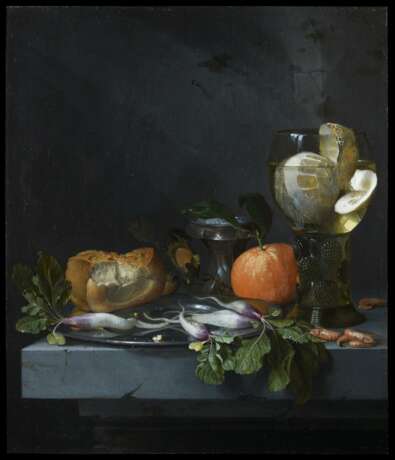Walscapelle, Jacob van (1644 Dordrecht - 1727 Amsterdam). Stillleben mit Krustentieren und Rettich
17.05.2018 17:00UTC +01:00
Classic
Sold
100000EUR € 100 000
| Auctioneer | VAN HAM Kunstauktionen GmbH |
|---|---|
| Event location | Germany, Köln |
| Buyer Premium | 32% |
Archive
The auction is completed. No bids can be placed anymore.

ID 68271
Lot 968 | Walscapelle, Jacob van (1644 Dordrecht - 1727 Amsterdam). Stillleben mit Krustentieren und Rettich
Estimate value
€ 100 000 – 150 000
Provenienz:
- Rheinische Privatsammlung (bis 1930);
- danach durch Erbfolge in Familienbesitz geblieben.
Wir danken Fred G. Meijer, Amsterdam für seine freundliche Unterstützung.
Fred G. Meijer zum Gemälde Jacob van Walscapelle
Die dekorativ angelegten Früchte-, Blumen- und Vanitasstillleben des Jacob van Walscapelle bestechen durch opulente Kompositionen und minutiöse Malerei. Sie zählen heute zu den Meisterstücken des niederländischen Goldenen Zeitalters.
Jacob van Walscapelle wurde als Jacobus Cruydenier in Dordrecht geboren. Schon in seiner Jugend übernahm er den Namen seines Urgroßvaters mütterlicherseits van Walscapelle.
Seine erste Ausbildung als Künstler erhielt er wohl in Dordrecht und vielleicht nicht direkt als Stilllebenmaler. Heute kennen wir jedoch nur seine Stillleben. Etwa Mitte der 60er Jahre des 17. Jahrhunderts war van Walscapelle Schüler des Malers Cornelis Kick (1631/34 - 1681) in Amsterdam. 1673 bekleidete er ein Amt in der Amsterdamer Tuchhalle. Der Künstlerbiograph Arnold Houbaken gibt an, dass van Walscapelle für dieses städtische Amt das Malen gänzlich aufgegeben habe. Dies wird widerlegt von der Tatsache, dass viele seiner bekannten Bilder aus der Zeit nach 1673 stammen; das Späteste ist 1699 datiert.
Blumen und Früchte waren die Hauptmotive in Jacob von Walscapelles Gemälden. Bis etwa 1670 dominierten Blumenstilleben im Stil Cornelis Kicks sein Werk, aber in der Folge scheint er zu einem gewissen Grad von den Werken der Utrechter Maler Jan Davidz. De Heem (bis etwas 1672) und von Abraham Mignon beeinflusst worden zu sein.
Das hier angebotene Stillleben mit einem Römer-Pokal, Rettich, einer Orange, Brot, Haselnüssen, Garnelen und einem Salzfass, die auf einer steinernen Tischplatte ausgebreitet sind, findet sich in dieser Form recht selten im Werk des Künstlers. Van Walscapelle scheint solche Stücke vorwiegend um die Mitte der 1670er Jahre gemalt zu haben. Diese minutiös ausgeführten, stark ausgeleuchteten und überaus plastischen Früchte und Gegenstände erinnern tatsächlich an Werke de Heems und insbesondere Mignons, die diese in der zweiten Hälfte der 1660er und den frühen 1670er Jahren gemalt haben. Ein signiertes Werk Mignons in Kopenhagen (Öl auf Holz, 45 cm x 34,5 cm, Statens Museum for Kunst, Inventar Nr. KMS 2083) sei als Beispiel genannt.
Jedoch ist bei van Walscapelle das Licht sanfter, sind die Konturen weniger scharf als bei Mignon, was seinen Stillleben eine stärkere Atmosphäre verleiht. Die Kombination seiner Eigenarten macht dieses Gemälde zu einem besonders eindrucksvollen und bezaubernden Beispiel für die flämische Stillleben-Kunst in der zweiten Hälfte des 17. Jahrhunderts.
Fred G. Meijer, Amsterdam, April 2018
| Auction house category: | Old Master Paintings |
|---|
| Auction house category: | Old Master Paintings |
|---|
| Address of auction |
VAN HAM Kunstauktionen GmbH Hitzelerstr. 2 50968 Köln Germany | ||||||||||||||
|---|---|---|---|---|---|---|---|---|---|---|---|---|---|---|---|
| Preview |
| ||||||||||||||
| Phone | +49 221 92586215 | ||||||||||||||
| Fax | +49 221 92 58 62 4 | ||||||||||||||
| Buyer Premium | 32% | ||||||||||||||
| Conditions of purchase | Conditions of purchase | ||||||||||||||
| Business hours | Business hours
|




